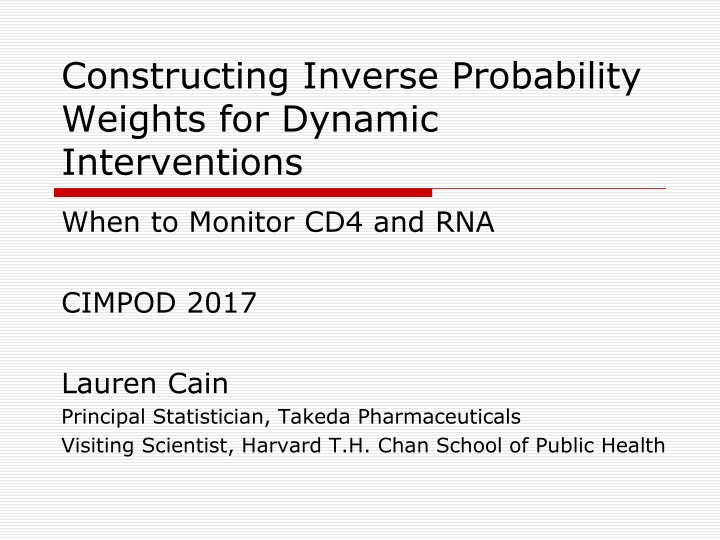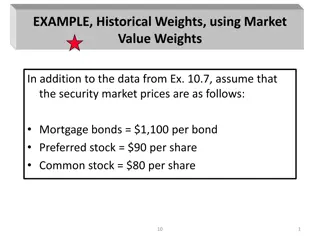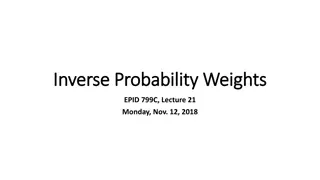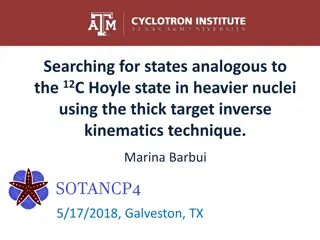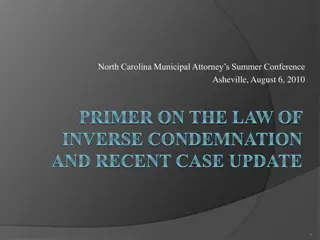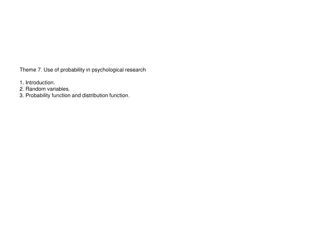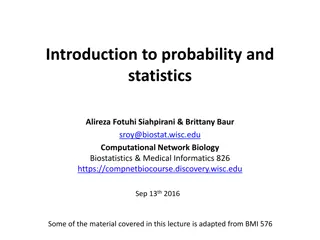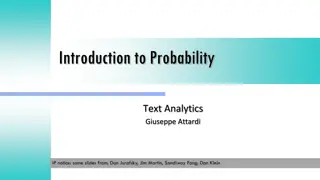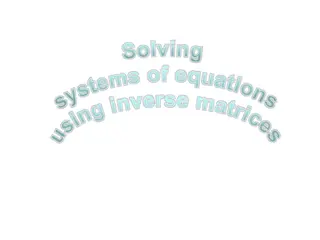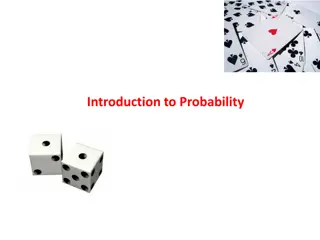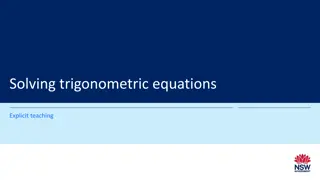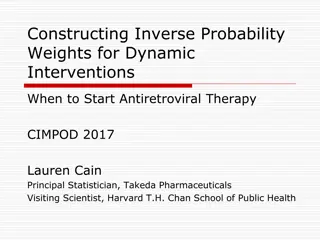Constructing Inverse Probability Weights for Dynamic Interventions
Principal Statistician Lauren Cain explores the optimal frequency for monitoring CD4 cell count and HIV RNA in individuals on treatment. Examples of dynamic monitoring strategies and classifications are discussed, shedding light on the implications for healthcare guidelines.
Download Presentation

Please find below an Image/Link to download the presentation.
The content on the website is provided AS IS for your information and personal use only. It may not be sold, licensed, or shared on other websites without obtaining consent from the author.If you encounter any issues during the download, it is possible that the publisher has removed the file from their server.
You are allowed to download the files provided on this website for personal or commercial use, subject to the condition that they are used lawfully. All files are the property of their respective owners.
The content on the website is provided AS IS for your information and personal use only. It may not be sold, licensed, or shared on other websites without obtaining consent from the author.
E N D
Presentation Transcript
Constructing Inverse Probability Weights for Dynamic Interventions When to Monitor CD4 and RNA CIMPOD 2017 Lauren Cain Principal Statistician, Takeda Pharmaceuticals Visiting Scientist, Harvard T.H. Chan School of Public Health
Acknowlegement Ellen Caniglia was the first author of this work Completed the analyses Drafted the paper Met with me to share her SAS code and help design the lab exercise 28 February 2017 When to Monitor
Outline for today 1. Introduction to the Case-Study 2. Guided Exercises with Example Data (Using SAS) 3. Q&A 28 February 2017 When to Monitor
1. Introduction to the Case-Study
Motivating question What is the optimal frequency with which to monitor CD4 cell count and HIV RNA? Can the monitoring frequency be decreased for healthy individuals on treatment? 28 February 2017 When to Monitor
Clinical guidelines: Examples of dynamic strategies Guidelines European AIDS Clinical Society Monitor CD4 Every 3-6 months Annually if CD4 >350 and undetectable viral load Every 3-6 months Annually if undetectable viral load and CD4>300 for 2 years Optional if undetectable viral load and CD4>500 for 2 years Monitor HIV RNA Frequently immediately following initiation Every 3-6 months thereafter 2-8 weeks after initiation Every 4-8 weeks thereafter Every 3-4 months once viral load undetectable Every 6 months once suppressed for >2 years Department of Health and Human Services 28 February 2017 When to Monitor
Strategy Classifications Static (non-dynamic) strategies: do not depend on time dependent covariates Dynamic strategies: depend on time dependent covariates 28 February 2017 When to Monitor
Examples of strategies: Initiate cART Static strategies at first visit after 3 months Dynamic strategies when CD4<500 when CD4<200 Rarely used in clinical practice Most RCTs Non optimal strategies Most common in clinical practice Rarely RCTs Optimal strategy is dynamic 28 February 2017 When to Monitor
Examples of strategies: Initiate cART after 3 months when CD4<500 id month CD4 cART id month CD4 cART 1 0 1 0 1 1 1 1 1 2 1 2 1 3 1 3 1 4 1 4 1 5 1 5 1 6 1 6 Strategy assigned at baseline Strategy assigned at baseline 28 February 2017 When to Monitor
Examples of strategies: Initiate cART after 3 months when CD4<500 id month CD4 cART id month CD4 cART 1 0 ? 0 1 0 ? ? 1 1 ? 0 1 1 ? ? 1 2 ? 0 1 2 ? ? 1 3 ? 1 1 3 ? ? 1 4 ? 1 1 4 ? ? 1 5 ? 1 1 5 ? ? 1 6 ? 1 1 6 ? ? Strategy assigned at baseline Treatment given known at baseline Strategy assigned at baseline Treatment given not known at baseline 28 February 2017 When to Monitor
Examples of strategies: Initiate cART after 3 months when CD4<500 id month CD4 cART id month CD4 cART 1 0 600 0 1 0 600 0 1 1 580 0 1 1 580 0 1 2 560 0 1 2 560 0 1 3 540 1 1 3 540 0 1 4 520 1 1 4 520 0 1 5 500 1 1 5 500 0 1 6 480 1 1 6 480 1 Strategy assigned at baseline Treatment given known at baseline Treatment does not depend on time-varying CD4 Strategy assigned at baseline Treatment given not known at baseline Treatment depends on time- varying CD4 28 February 2017 When to Monitor
Clinical Paper The HIV-CAUSAL Collaboration CNICS Used IP weighting methods to compare dynamic monitoring strategies 28 February 2017 When to Monitor
Methods Paper Subset of HIV-CAUSAL Collaboration How to use IPW to compare dynamic strategies with grace periods 28 February 2017 When to Monitor
The HIV-CAUSAL Collaboration: Contributing cohorts France: FHDH, PRIMO, SEROCO Spain: PISCIS, CoRIS, CoRIS MD, GEMES UK: UK CHIC, UK Register of Seroconverters Netherlands: ATHENA Switzerland: SHCS United States: VACS-VC Greece: AMACS Canada: South Alberta HIV Cohort Brazil: IPEC 28 February 2017 When to Monitor
The CNICS: Contributing cohorts Case Western Reserve University Fenway Community Health Clinic Johns Hopkins University University of Alabama at Birmingham University of California at San Diego University of California at San Francisco University of North Carolina University of Washington 28 February 2017 When to Monitor
Sample Size 28 February 2017 When to Monitor
Baseline covariates Cohort Sex Age Race (white, black, other or unknown) Geographic origin (Western developed countries, other or unknown) Acquisition group (heterosexual, homosexual/bisexual, injection drug use, other or unknown) CD4 cell count HIV-1 RNA Calendar year Years since HIV diagnosis Months to suppression 28 February 2017 When to Monitor
Time-varying covariates CD4 cell count HIV-1 RNA Time since last laboratory measurement AIDS-defining illness (when outcome is death) 28 February 2017 When to Monitor
3 monitoring strategies Monitor CD4 cell count and HIV-RNA once every 3 1 months 6 1 months or 3 1 months if HIV-RNA > 200 or CD4 200 9-12 1 months or 3 1 months if HIV-RNA > 200 or CD4 200 Optimal strategy = highest AIDS-free survival 28 February 2017 When to Monitor
Preferred method: Randomized clinical trial (RCT) Identify eligible individuals HIV-positive, AIDS-free Virologically suppressed within 12 months of cART initiation Randomly assign each eligible individual to one of the 3 strategies Follow until AIDS, death or administrative end of follow-up 28 February 2017 When to Monitor
Alternative method: Emulate a RCT Use observational data Identify eligible individuals & observations Baseline = Date of confirmed virologic suppression following cART initiation (within 12 months) HIV-positive, AIDS-free, CD4 measurement at baseline Determine which of the 3 strategies they are following Assign them to follow those strategies Artificially censor them if and when they deviate Follow until AIDS, death, censoring, or administrative end of follow-up 28 February 2017 When to Monitor
Need for causal inference methods Traditional methods cannot appropriately adjust for time-varying confounders affected by prior exposure CD4/RNA affect decision to monitor Monitoring may affect future values of CD4/RNA The comparison of dynamic strategies requires novel statistical methods designed specifically for dynamic strategies and time-varying confounding 28 February 2017 When to Monitor
2. Guided Exercises with Example Data (Using SAS)
Example Data Simulated data set based on the HIV-CAUSAL Collaboration Using a random sample of eligible individuals from that data set 28 February 2017 When to Monitor
Simulated v. real data No losses to follow up One lab measurement per month Temporal order of variables within month known Lab measurements Treatment Censoring Outcome 28 February 2017 When to Monitor
Pre-Processing of Data Identify eligible individuals & observations Found baseline and set it to month = 0 Removed ineligible individuals and observations AIDS or death as the event 28 February 2017 When to Monitor
Getting Started Open the program: analysis_wtm.sas Read in the data set: wtm_aidsdeath.sas7bdat Look carefully at the data 28 February 2017 When to Monitor
Step 0: Create a time-varying monitoring variable for use in the weight models Categorize several continuous variables 28 February 2017 When to Monitor
Step 1: Fit a model for monitoring using proc logistic Merge the output of the proc logistic with the original data set 28 February 2017 When to Monitor
Step 2: Create 3 replicates of each individual 28 February 2017 When to Monitor
Step 2: Why are we creating replicates? All individuals have data that are consistent with all 3 strategies at baseline 1. Randomly allocate an individual to one of the strategies he follows 2. Assign individuals to follow more than one strategy 28 February 2017 When to Monitor
Step 3: Censor replicates when they deviate from their assigned strategy Identify the beginning of each monitoring grace period Count the replicates and events for each strategy 28 February 2017 When to Monitor
Step 3: Reasons for censoring: Monitored too soon Not monitored soon enough CD4 or RNA monitored, but not both Note: Censoring is a function of Monitoring A subset of the prognostic factors (i.e., CD4 and RNA) 28 February 2017 When to Monitor
Step 3: Example An individual is monitored every 6 months She has data consistent with all 3 strategies at baseline 3 copies (1 per strategy) Censor the copies if she is: Monitored too soon Not monitored soon enough 28 February 2017 When to Monitor
Step 3: Example of censoring process Copy 1 3 months month Copy 2 6 months month Copy 3 9-12 months month monitor 28 February 2017 When to Monitor censor
Step 4: Build the unstabilized IP weights Truncate the weights 28 February 2017 When to Monitor
Step 4: Why are we building IP weights? Censoring may introduce time- dependent selection bias Weight by the inverse probability of remaining uncensored 28 February 2017 When to Monitor
Step 4: Weights for monitoring or for censoring? Recall: Censoring is a function of Monitoring CD4/RNA Conditional probability of remaining uncensored = Conditional probability of not monitoring (before the grace period) = Conditional probability of monitoring CD4 or RNA but not both (during the grace period) = Conditional probability of monitoring (end of the grace period) 28 February 2017 When to Monitor
Step 4: Adjusting for time-varying selection bias Use IP weighting to create a pseudo-population in which monitoring is independent of measured past prognostic factors In the pseudo-population, the artificial censoring is noninformative Under the assumptions of conditional exchangeability, positivity, and consistency 28 February 2017 When to Monitor
Step 4: IP Weights 28 February 2017 When to Monitor
Step 4: Contributions to the weights Time Point Before gp During gp End of gp Contribution 1/p_w_d_0 1 (1/p_w_d_1) 1/p_w_d_2 j < 0 0 j < m j = m 28 February 2017 When to Monitor
Step 4: Stabilized weights? Issues with unstabilized weights High weight to subjects with low probability of receiving the exposure level that they indeed received Estimators with large variance Stabilized weights preferred (for static strategies) Estimators with smaller variance Easier to evaluate model specification 28 February 2017 When to Monitor
Step 4: Stabilized weights? Common stabilization procedures for static strategies are not valid for dynamic strategies Numerator can depend on regime and time- varying covariates, but not past monitoring In practice, simple stabilization does not actually stabilize Optimal, locally semiparametric efficient weights derived by Orellana et al., 2010ab 28 February 2017 When to Monitor
Step 4: Truncated weights? Reset the value of the highest (and lowest) weights Reduce influence of observations with extreme weights Increases bias and precision 28 February 2017 When to Monitor
Step 5: Fit an inverse-probability weighted dynamic marginal structural model to estimate the hazard ratios 28 February 2017 When to Monitor
Step 5: Proc Surveylogistic Replicates are correlated Must adjust variance estimation to account for replicates Robust variance (cluster statement) Bootstrap entire process 28 February 2017 When to Monitor
Step 6: Fit a pooled logistic model with interactions between regime and time Estimate the 18-month AIDS-free survival Plot the AIDS-free survival curves 28 February 2017 When to Monitor
Step 6: The procedure Fit a model like the one in Step 5, but with interactions between regime and time Create a skeleton data set with all possible time points for each individual under each treatment strategy Score the skeleton data set using the output of the pooled logistic model to get predicted probabilities of the event Calculate and graph the AIDS-free survival at each time for each strategy 28 February 2017 When to Monitor
Causal Interpretation Hazard ratios (or survival) that would have been estimated had all individuals been monitored according to the study protocol 28 February 2017 When to Monitor
Assumptions No unmeasured confounding given the measured covariates Correct specification of the model for monitoring as a function of the measured confounders Positivity (i.e., no deterministic assignment of the monitoring strategies) 28 February 2017 When to Monitor
